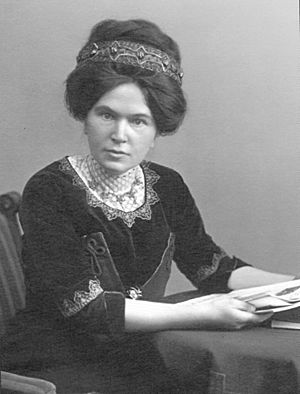Aspazija facts for kids
Quick facts for kids
Aspazija
|
|
|---|---|
 |
|
| Born | 16 March 1865 Zaļenieki parish, Russian Empire
|
| Died | 5 November 1943 (aged 78) Jūrmala, Ostland (Now Latvia)
|
| Occupation | Poet Playwright politician |
| Movement | Romanticism |
| Spouse(s) | Rainis |
| Awards | Order of the Three Stars Cross of Recognition |
Aspazija was the pen name of Elza Johanna Emilija Lizete Pliekšāne (born Elza Rozenberga). She was born on March 16, 1865, and passed away on November 5, 1943. Aspazija was a famous Latvian poet and playwright. A pen name is a special name a writer uses instead of their real name. Her pen name, Aspazija, is the Latvian way of saying the ancient Greek name Aspasia.
Contents
The Early Life of Aspazija
Aspazija grew up in a wealthy farming family near Jelgava, Latvia. This was in 1865. She went to school there and was active in youth groups. She left high school (gymnasium) in her last year. In 1886, she married Wilhelm Max Valter.
Starting Her Writing Career
Later, Aspazija became very interested in literature. She especially liked German writers. Her first writing was published in 1887. It appeared in a newspaper called Dienas Lapa. In 1891, she divorced her husband. She then worked as a private teacher until 1893. In 1893, she moved to Riga and started working as a journalist. Her first plays were shown in Riga in 1894. These plays were called Vaidelote and Zaudētās tiesības.
Meeting Rainis and Life in Exile
During these years, Aspazija met Jānis Pliekšāns. He was better known as Rainis. Rainis was a newspaper editor, poet, lawyer, and a leader of a group called the New Current. This group wanted to bring new ideas to Latvia. Aspazija joined the New Current because of Rainis.
Marriage and Forced Travel
Aspazija and Rainis got married in 1897. They moved to Panevėžys, Lithuania. This happened after the government stopped the New Current movement. In the same year, Aspazija published her first collection of poems. Rainis was put in prison for his activities. He was then sent away (exiled) to Russia for five years, from 1897 to 1903. Aspazija went with him. They worked together to translate many books by Johann Wolfgang von Goethe into Latvian.
Return to Latvia and New Challenges
After their exile, they returned to Latvia. They both continued to write. Rainis also became involved in socialist politics. In 1905, a big protest movement, called the 1905 Revolution, started in Russia. It quickly spread to Riga. Many people were killed on January 13, 1905. Aspazija's play "Vaidelote" (The Vestal) was shown in January. People saw it as a call for Latvia to break away from the Russian Empire. Because of the protests, the ruler (czar) ordered a crackdown. Many people involved in the revolution were arrested or killed. So, Rainis and Aspazija had to leave Latvia. They fled to Switzerland and lived there from 1905 to 1920.
Aspazija's Later Life and Legacy
After World War I, Latvia became an independent country. Aspazija and Rainis returned home in 1920. Aspazija became very active in the feminist movement. This movement works for equal rights for women. She also joined the Latvian Social Democratic Workers' Party. She was elected to the Constitutional Assembly of Latvia. This assembly helped create Latvia's new government.
Final Years and Passing
Rainis passed away in 1929. After his death, Aspazija lived a quiet life. She stayed mostly in Riga or at her summer house in Dubulti. She died on November 5, 1943, in Dubulti. She was buried next to her husband in the Rainis cemetery in Riga.
Aspazija's Literary Works
Aspazija's first writings were realistic. This means they showed life as it truly was. However, most of her work is neo-romantic. This style often looks back at the past with a sense of longing.
Famous Plays and Their Meanings
For example, her play Vaidelote was written in 1894. It takes place in the 14th century in the Grand Duchy of Lithuania. A vaidelote was a female servant to gods in ancient Lithuanian stories. Her plays Simple Rights and Unattained Goals caused many discussions. This was because they spoke out against a society where men held all the power (a patriarchal society). Her play Silver Veil (Sidraba šķidrauts) is often thought to be her best work. In 1923, she even wrote a play titled Aspazija, named after herself.
Poetry Collections and Themes
In her poetry book Red Flowers, everyday things are seen in a romantic and beautiful way. Her poems are also full of light, imagination, and a rebellious spirit. In Soul's Twilight (1904), her poems show more sad or pessimistic feelings. While she lived abroad, Aspazija wrote two poetry books: Sunny Corner and Spread Wings. These collections focused less on social issues. Instead, they explored more personal feelings and less rebellion against society.
See also
 In Spanish: Aspazija para niños
In Spanish: Aspazija para niños


